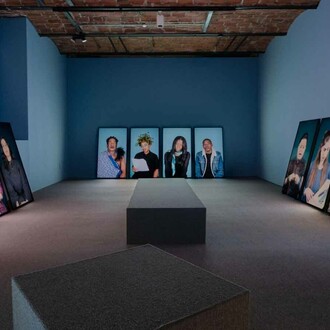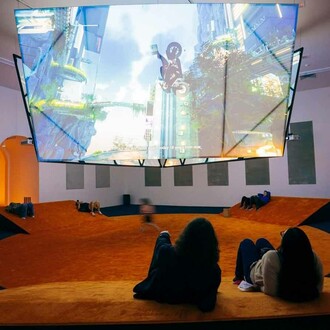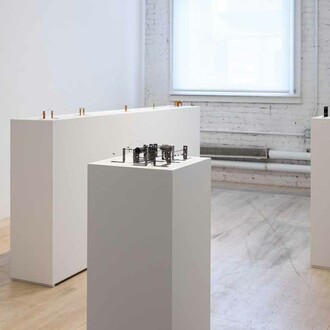Artist and activist Nancy Spero (American, 1926–2009) produced a radical body of work that confronted oppression and inequality while challenging the aesthetic orthodoxies of contemporary art. Among the first feminist artists, Spero drew on archetypal representations of women across various cultures and times in an attempt to reframe history itself from a perspective that she termed “woman as protagonist.” Organized by artist and curator Julie Ault, Paper Mirror traces the full arc of Spero’s artistic evolution, bringing together more than 100 works made over six decades in the first major museum exhibition in the US since the artist’s death in 2009.
Spero began her career as a figurative painter in Paris during the 1950s; for her, choices of material, form, and subject were always political. In the 1960s, faced with the atrocities of the Vietnam War, she concluded that painting had become “too conventional, too establishment.” Abandoning canvas for paper, Spero’s The War Series (1966–70) conveyed her outrage in depictions of sexualized bombs that personified the gendered brutality of the conflict. From 1966 onward, she worked primarily on paper―pinning her fragile compositions directly to the wall―and women’s history gradually but emphatically became the central subject of her art.
In her scroll-like compositions of the early 1970s, Spero appropriated the French poet Antonin Artaud’s language of “cruelty” to evoke her self-described “loss of tongue” as a female artist in a male-dominated art world. Placing fragments of text alongside female figures derived from a vast range of sources across history, Spero probed the gendered relationship between language and power. Using hand printing, she recycled and transposed a recurring cast of figures that dance, glide, leap, run, and tumble from one work to the next. Collaged together from mythology, folklore, art history, literature, and media―and presented in increasingly experimental formats, from scrolls to friezes and room-sized installations―Spero described her works as “ephemeral monuments” to the full range of women’s experience: tragic and triumphant, degraded and powerful, victimized and liberated.
Nancy Spero: Paper Mirror surveys the full scope of Spero’s career, including her Black Paintings of the 1950s; the War Series of the 1960s; the Artaud works of the 1970s; the Licit Exp and Hours of the Nights series of 1974; as well as numerous works from the 1980s, 1990s, and 2000s. The MoMA PS1 presentation of the exhibition will include the artist’s monumental work Notes in Time on Women (1979–81), a 200-foot-long frieze from the collection of The Museum of Modern Art, on view for the first time in more than a decade. Also featured is the large-scale installation Maypole: Take No Prisoners (2007), the last major work the artist completed before her death, originally realized for the Venice Biennale. Installed in MoMA PS1’s first-floor Duplex gallery, the work consists of a 20-foot vertical steel pole from which images of decapitated heads are suspended by ribbons and metal chains. Created during the Iraq War but derived from Spero’s earlier drawings that responded to the Vietnam War, Maypole provokes inquiry into the cyclical nature of history, war, and its victims. In addition, the exhibition includes a selection of documentary films by Irene Sosa, which feature original footage of Spero at work.
This exhibition is a part of Spring 2019. Nancy Spero was born in Cleveland, Ohio, and graduated from the School of the Art Institute of Chicago in 1949. She trained at the Ecole des Beaux-Arts in Paris, where she lived from 1959 until 1964. Spero, her husband (the painter Leon Golub), and their three sons eventually settled in New York City, where she lived until her death in 2009. As an activist, Spero participated in the Women Artists in Revolution (WAR) and the Art Workers Coalition in the 1960s and in 1972 cofounded A.I.R. Gallery, the first independent women’s art venue in the US. As an artist, her work was widely exhibited in her lifetime and has been the subject of numerous monographic museum exhibitions over the past decade, including major retrospectives at the Centre Pompidou, Paris; Serpentine Gallery, London; Museum der Moderne, Salzburg; Museo d’art Contemporani de Barcelona; and the Museo Nacional Centro de Arte Reina Sofia, Madrid. Since the 1980s, she has been included in dozens of major group exhibitions, including the Venice Biennale, Documenta, and the Whitney Biennial.
Julie Ault (American, b. 1963) is an artist, curator, writer, and editor whose work frequently adopts curatorial and editorial activity as creative practice. Ault has long engaged Spero’s work in writing, publications, and exhibitions. She was a cofounder of the art collective Group Material (active between 1979 and 1996), and her work as an artist and curator has been exhibited at the São Paulo and Whitney Biennials and at such venues as Artists Space, the Weatherspoon Art Museum, and the Secession, Vienna, among others. Her book Alternative Art New York, 1965–1985 (2002) documents the critical role that alternative art groups and spaces played in the development of politically progressive and inclusive practices. Her additional publications include Show and Tell: A Chronicle of Group Material (2010), Two Cabins by James Benning (2011), and In Part: Writings by Julie Ault (2017). In 2018 Ault was named a Fellow of the MacArthur Foundation.
















